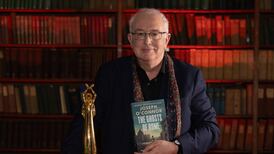The recently revealed controversy of insourcing in public hospitals – where hospital equipment and HSE staff were co-opted by private businesses for use outside regular working hours to treat patients – has cast a shadow over the delivery of healthcare in Ireland.
The HSE Spark Innovation Programme, which celebrates initiatives within the public healthcare system offering improvements to patient care, is an antidote to such questionable healthcare practices.
The programme, which began in 2017 seeking better communications for junior doctors on hospital rotations, has grown to include innovations by all healthcare professionals in public hospitals across the State. In 2025, there were just under 100 entries, with 13 projects receiving awards.
“It can be about improving access to care, reducing waiting times, improving the patient experience or finding a way of optimising resources through digital technology,” explains Caitriona Heffernan, the national clinical and innovations lead at the HSE Spark Innovation Programme.
RM Block
Offering patients healthcare closer to their homes was the theme of several projects which were celebrated at the 2025 annual awards. These included community-based dementia care, mothers-and-babies groups for marginalised new mothers in one of Limerick’s most disadvantaged areas, and home-based rehabilitation delivered by healthcare assistants trained by occupational therapists at University Hospital Waterford.
However, another winner, the Patch Me If You Can/Virtually Pain Free project is an example of innovation which can be applied to different groups of patients in different healthcare settings. This project was developed by advanced nurse practitioner Anne Marie Kiernan at the Croom Orthopaedic Hospital in Limerick, to help chronic pain patients cope with the pain felt during the application of pain patches.
“These pain patches – which are derived from chilli peppers – have a pain-relieving effect that can last for 12 weeks. They are the first non-invasive (ie not involving injections) treatment for neuropathic pain but they can cause pain and burning when they are being put on,” explains Kiernan. Neuropathic pain is nerve pain linked to diabetes, shingles, chemotherapy and other conditions.
Kiernan found that, although the pain patches offered good medium-term pain relief – even allowing some patients to reduce opioids and other pain medication – many patients couldn’t tolerate the initial pain during application and requested the procedure to be halted midway through.
[ Dementia and AI: ‘I’ve never seen something quite like this’Opens in new window ]
Kiernan tried using music therapy and other non-pharmacological pain distraction techniques to help the patients withstand the pain during the hour-long application procedure. But, when this didn’t work, she looked further and discovered that virtual and augmented reality headsets can offer excellent distraction from pain and discomfort.
Virtual reality is a fully immersive digital experience while augmented reality overlays three-dimensional imagery into the real world. Crucially, augmented reality can also be accessed via a smartphone.

“So, I applied augmented reality at the halfway point in the hour-long treatment – a point when many patients previously stopped the treatment. And, we found their pain scores reduced by half within 15 minutes, allowing them to complete the one-hour application of the pain patches,” explains Kiernan.
Buoyed up by her success and with funding from the Spark Innovation Programme, Kiernan worked with technologists to develop an affordable smartphone-based virtual reality platform for patients to use as a distraction from their pain at home.
“The idea is that they can reach for the headset to use mindfulness and guided imagery instead of reaching for a pain-relieving medication,” says Kiernan. The cost per patient for use of this technology is €43 for six months.
Since her project began, Kiernan has had queries from pain management specialists in both paediatric and maternity hospitals who are interested in using augmented and virtual reality headsets with children undergoing painful treatments, and mothers during labour.
A new digital system to diagnose patients with sleep apnoea at St James’s Hospital in Dublin was another standout winner at the Spark Innovation 2025 awards. “About 50 per cent of GP referrals to the respiratory medicine clinics at the hospital now are for sleep apnoea, partly due to increased awareness of the condition and partly due to higher rates of obesity which makes people more likely to develop it,” explains Prof Brian Kent, consultant respiratory and sleep physician at St James’s Hospital.
We’d like to see patients involved more in designing services rather than see them as having to shape-shift to fit into the service
— Caitriona Heffernan
Sleep apnoea is a sleeping disorder in which breathing is disrupted, resulting in unrefreshing sleep, daytime tiredness and sleepiness. This increase in GP referrals for sleep apnoea has led to delays of up to three years for many patients’ first visit to a consultant.
The so-called Virtual Obstructive Sleep Apnoea Identifier Pathway was devised as a solution to these long delays. “We developed the myPatientSpace app where patients download a questionnaire about their symptoms, co-morbidities, medication, lifestyle, etc and following that, we send each patient a single-use sleep apnoea testing devise, the data from which is uploaded into a cloud platform that we access,” explains Kent.
Following analysis of the questionnaire and sleep data, the patient is then invited to a virtual consultation via the app. “This usually lasts about 15 minutes rather than the usual 30 minutes for in-person consultations because we have all the information already,” he adds.
Kent says that, initially, the project limited the digital diagnostic route to patients under 65. “Sleep apnoea usually becomes noticeable in middle age and people are diagnosed in their 50s and 60s and because we don’t have enough sleep clinics in Ireland, this approach offers an alternative diagnostic route.”
He adds that while the overall satisfaction rate was high, there were about one in 10 patients who struggled with the technology-based approach. “If we are concerned about someone’s ability to complete the questionnaire or other issues, we are happy to see them in the traditional clinical setting.”
Heffernan says that healthcare professionals deserve credit for making the effort to find innovative solutions for specific patient populations. “The reality is that these healthcare professionals deliver these projects alongside their day jobs. They don’t have allocated time to do these projects so the annual Spark summit is an opportunity to showcase, promote, acknowledge and celebrate their work,” she says.

The Spark Innovation Programme also offers mentoring and supervision as well as funding to develop pilot projects, with the aim that, upon completion, they may also be applied in other settings.
Perhaps unsurprisingly, with artificial intelligence (AI) gaining attention across the world in healthcare, education and other sectors, 2025 saw the introduction of an entire strand dedicated to AI. Yet Heffernan is adamant that human-centred design thinking is pivotal to the awards.
“We’d like to see patients involved more in designing services rather than see them as having to shape-shift to fit into the service.”





















